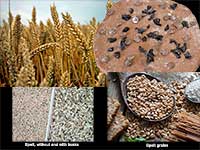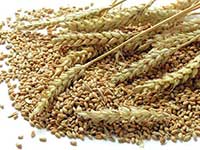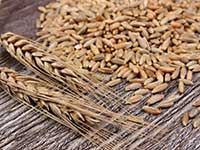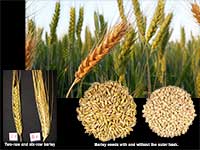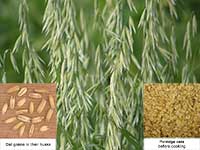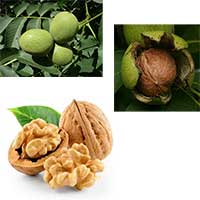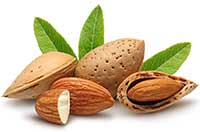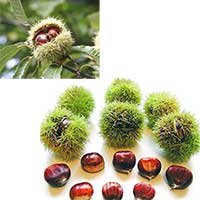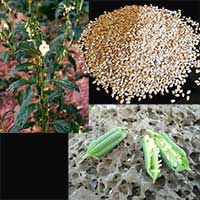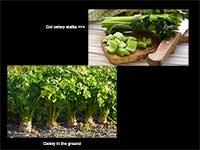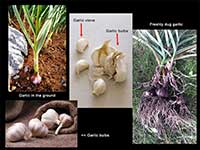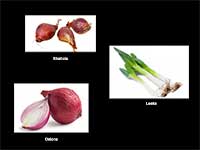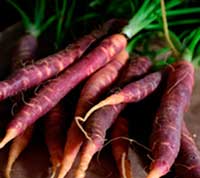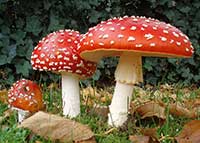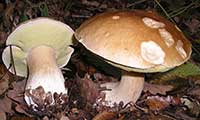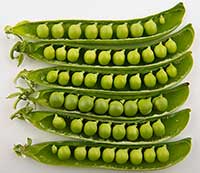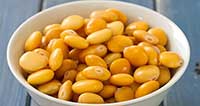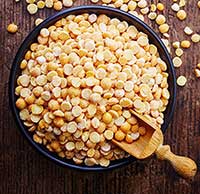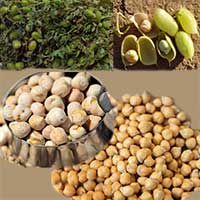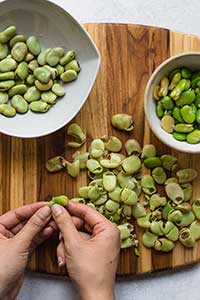Ingredients in Roman Recipes
Something to remember: The Romans did not always use the same names or varieties of things as we do... To them, "corn" was wheat, not the maize we refer to today. Another example would be cucumbers — not the green vegetable we think of today, but instead the Cucumis Melo, of the Cucurbitaceae family popularly known as the "Santa Claus", "Christmas", or "Toadskin" melon. I know this page is kind of long and a hodgepodge, but we will get it more streamlined. Just updating it and getting it started to be more useful.
As ALWAYS, your input is welcome. ~DMV
Common Spices and Ingredients
Here, above are some common spices and ingredients. Below that, there is a very detailed article by Correus, along with photos and more details on some of these ingredients. More photos will be added as time goes by.
The aroma of raw asafoetida isn't exactly what you'd call pleasant, but everything changes when it's introduced to hot oil or butter. Usually one of the first aromatics added to a dish, its initial pungent and camphorous funk mellows out and is replaced by musky aromas that evoke a sense of place, more than any comparable flavors. It's hard to describe asafoetida, but you know it when you smell it, and if you're a fan of this style of cooking it'll be right up your alley.
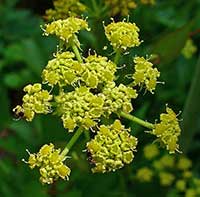 Liebstoeckl
Liebstoeckl(Lovage) — A plant with yellow flowers and is a kind of celery. The leaves can be used in salads, or to make soup or season broths, and the roots can be eaten as a vegetable or grated for use in salads. Its flavor and smell can be described as a mix of celery and parsley, but with a higher intensity of both of those flavors. The seeds can be used as a spice, similar to fennel seeds. In the UK, an alcoholic lovage cordial is traditionally mixed with brandy in the ratio of 2:1 as a winter drink. In Romania, the leaves are the preferred seasoning for the various local broths, much more so than parsley or dill. In the Netherlands it is the only non salt ingredient of a traditional asparagus dish.
The roots, which contain a heavy, volatile oil, are used as a mild aquaretic. Lovage root contains furanocoumarins which can lead to photosensitivity.In Romania it is also used dried and with seeds to conserve and to add flavour to pickled cabbage and cucumbers.
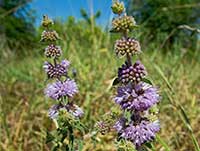 Pennyroyal (Mentha pulegium) — is a Eurasian plant with hairy leaves and small mauve flowers, yielding an aromatic oil. Here is a link to it's wiki page. Also called Poleiminze. Pennyroyal was commonly incorporated as a cooking herb by the Greeks and Romans. A large number of the recipes in Apicius call for the use of pennyroyal, often along with such herbs as lovage, oregano and coriander. Although it was commonly used for cooking also in the Middle Ages, it gradually fell out of use as a culinary herb and is seldom used as such today.
Pennyroyal (Mentha pulegium) — is a Eurasian plant with hairy leaves and small mauve flowers, yielding an aromatic oil. Here is a link to it's wiki page. Also called Poleiminze. Pennyroyal was commonly incorporated as a cooking herb by the Greeks and Romans. A large number of the recipes in Apicius call for the use of pennyroyal, often along with such herbs as lovage, oregano and coriander. Although it was commonly used for cooking also in the Middle Ages, it gradually fell out of use as a culinary herb and is seldom used as such today.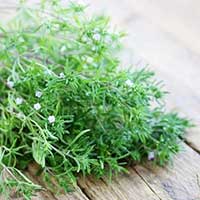 Saturei (Summer savory) — Summer savory (Satureja hortensis) A violet or white flowered plant that grows mainly in Southern Europe, and is used as a spice plant, especially for bean dishes. First mentioned in classical Greek literature and used as a culinary and medicinal herb by the Ancient Romans, savory was also one of the first herbs brought to the New World from Europe and therefore has relevance in the history of American cooking as well.
Saturei (Summer savory) — Summer savory (Satureja hortensis) A violet or white flowered plant that grows mainly in Southern Europe, and is used as a spice plant, especially for bean dishes. First mentioned in classical Greek literature and used as a culinary and medicinal herb by the Ancient Romans, savory was also one of the first herbs brought to the New World from Europe and therefore has relevance in the history of American cooking as well.  Spikenard — An aromatic plant with small leaves and red-purple flowers. Spikenard, also called nard, nardin, and muskroot, is a class of aromatic amber-colored essential oil derived from Nardostachys jatamansi, a flowering plant of the valerian family which grows in the Himalayas of Nepal, China, and India. The oil has been used over centuries as a perfume, a traditional medicine, or in religious ceremonies across a wide territory from India to Europe.
Spikenard — An aromatic plant with small leaves and red-purple flowers. Spikenard, also called nard, nardin, and muskroot, is a class of aromatic amber-colored essential oil derived from Nardostachys jatamansi, a flowering plant of the valerian family which grows in the Himalayas of Nepal, China, and India. The oil has been used over centuries as a perfume, a traditional medicine, or in religious ceremonies across a wide territory from India to Europe.
- Interesting article on The Sustainability of Spikenard.
Common Ancient Roman Ingredients
Submitted by Correus — art added by DMV
Bread:
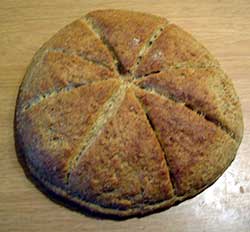 Bread was perhaps THE staple that would be found on every table, in every home — regardless of social status. Flour used in making bread varied, anywhere between coarse wholemeal to fine white. Originally fine white bread was only eaten by the rich, yet by the Empire it was common for all. Just as now, coarse wholemeal was thought to be heartier and healthier — Augustus was a proponent. Bread could be unleavened, leavened, and sourdough. It could be plain or flavored. There was popular bread imported from Alexandria — Panis Alexandrinus — that was flavored with cumin and honey.
Bread was perhaps THE staple that would be found on every table, in every home — regardless of social status. Flour used in making bread varied, anywhere between coarse wholemeal to fine white. Originally fine white bread was only eaten by the rich, yet by the Empire it was common for all. Just as now, coarse wholemeal was thought to be heartier and healthier — Augustus was a proponent. Bread could be unleavened, leavened, and sourdough. It could be plain or flavored. There was popular bread imported from Alexandria — Panis Alexandrinus — that was flavored with cumin and honey.
Grains:
Grains were a mainstay of the lower classes but Ancient Romans as a whole ate wheat, alica, emmer, spelt, and barley, millet, farro, rye, oats, and panic. Millet and panic were the primary grains used for porridges.
Most common flours were made with spelt, wheat (triticum), rye and millet (mainly southern Italy). Barley and oats were more common as wholemeal flours. Basically ANY bread can be used. Traditional, Old World artisanal breads from places such as WalMart are good and easy to get.
Fruits:
Even though fruit was often used as an ingredient in cooking, most fruit was eaten fresh and, of course, in season!! The Romans did, however, dry some fruits for use in cooking and to be eaten in the off season.
Most common fruits eaten by the Romans: apples (3 cultivars), pears (35 cultivars), figs, grapes, quinces, citron, strawberries, blackberries, elderberries, currants, plums, damsons, dates, melons, rose hips and pomegranates.
Less common but very popular, and expensive, were cherries and apricots (1st century BC) and peaches (1st century AD).
Nuts:
Pistachio, Walnut, Almond, Hazlenut, Pine Nut, Chestnut and Sesame seeds
Vegetables:
The Ancient Romans were very, very fond of their veggies. Patrick Faas describes it best in his book “Around the Roman Table”.
“A Roman patrician’s pride and joy were his vegetables. Earning money from trade was considered vulgar, fishing was for decadent Greeks, and the herding of cattle was left to barbarians. Vegetable-growing, though, was perfectly acceptable.”
Following are the veggies known to the Romans and easy to find nowadays.
Celery, Garlic, Yellow Squash (not 100% sure it’s the same as ours — edible gourds would be better), Lettuce, Endive, Shallots, Onion, Leeks, Fennel, Asparagus, Radishes, Turnips, Parsnips, Carrots (in Roman times they WERE NOT orange), Beets, Green Peas, Chard, Chicory, Green Beans, Cardoons (Artichoke Thistle), Olives, and "Cucumber." [Yes, I'm sure we'll get photos of other ancient varieties of veggies here soon. Not today though — my head hurts]
Brussels sprouts, artichokes, sweet peas, rutabaga and cauliflower were eaten by the Ancient Romans — however, the modern cultivated forms we know and eat today were not developed until the late Middle Ages and early Renaissance times.
Brassicas
The genus Brassica is known for its important agricultural and horticultural crops and includes a number of weeds, both of wild taxa and escapees from cultivation. Brassica species and varieties commonly used for food include broccoli, cauliflower, cabbage, choy sum, rutabaga, turnip and some seeds used in the production of canola oil and the condiment mustard. Most are seasonal plants (annuals or biennials), but some are small shrubs.
The genus is native to Western Europe, the Mediterranean and temperate regions of Asia. Many wild species grow as weeds, especially in North America, South America, and Australia.
Mushrooms
The Ancient Romans LOVED mushrooms and the most common and popular was the Amanita mushrooms, Boletus mushrooms, truffles, and various wild Agaricus mushrooms. Since mushrooms were not cultivated but gathered, stick with those that at least “look” wild if they are part of a display. For cooking I would still stick with those — just stay away from Asian and canned.
Legumes
The Ancient Romans ate tons of legumes — and they were a staple of the poor. The legumes eaten by the Ancient Romans included dried peas, sweet peas, lupins, lentils and fava beans. Of all of these, the most popular of the legumes was the chickpea and they had several varieties of these! *A Note: Some of the most common legumes eaten here in the US — black beans, blacked eyed peas, navy, kidney and so on — were not known to the Ancient Romans.
Also, a health alert: Fava beans are known to be deadly to people with a genetic deficiency of the enzyme glucose-6-phosphate dehydrogenaise (G6PD), children being particularly vulnerable. While rare, this deficiency is found in some ethnic groups, Africans and people of Mediterranean descent — ironically the regions where fava beans are most consumed.
Meat:
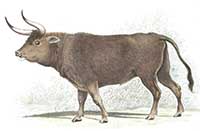 Following are the various “meats” eaten by the Ancient Romans. Keep in mind though that the Ancient Romans did not eat meat like we do today — it was too expensive. Meat consumption as seen via Asia and the Mediterranean follows Roman meat eating closer than the typical diet in the US.
Following are the various “meats” eaten by the Ancient Romans. Keep in mind though that the Ancient Romans did not eat meat like we do today — it was too expensive. Meat consumption as seen via Asia and the Mediterranean follows Roman meat eating closer than the typical diet in the US.
the extinct Ancient Auroch
Beef was eaten by the Ancient Romans but it was rare and very expensive. When it was eaten it was typically during a religious event. Veal was a favorite.
Sheep and Goat were eaten but it was just slightly eaten more than beef for the same reasons.
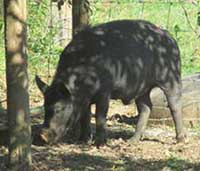 Pork was the most favorite meat eaten by the Ancient Romans with ham, bacon and chops being the most favorite parts. Aside of eating these parts as standalone cuts the Ancient Romans loved pork in the form of sausages.
Pork was the most favorite meat eaten by the Ancient Romans with ham, bacon and chops being the most favorite parts. Aside of eating these parts as standalone cuts the Ancient Romans loved pork in the form of sausages.
If you are going to cook meat, especially at a reenactment event, ham and bacon (not sliced, grocery store bacon) is your best bet.
Poultry:
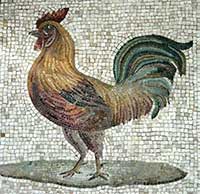 Poultry was a bit easier for the common Roman to obtain and eat. The most common poultry that Romans and the Romans in Britain would be eating, would be chickens, capons, geese, ducks, pigeons (especially wood pigeons) and doves. However, the Ancient Romans would eat just about ANY bird they could catch such as, blackbirds, finches, titmice, quails, larks, partridges, pheasants, thrush, figpeckers, warblers and even swans and peacocks. However, they would not eat woodpeckers or owls.
Poultry was a bit easier for the common Roman to obtain and eat. The most common poultry that Romans and the Romans in Britain would be eating, would be chickens, capons, geese, ducks, pigeons (especially wood pigeons) and doves. However, the Ancient Romans would eat just about ANY bird they could catch such as, blackbirds, finches, titmice, quails, larks, partridges, pheasants, thrush, figpeckers, warblers and even swans and peacocks. However, they would not eat woodpeckers or owls.
The Ancient Romans also loved eggs — any kind of egg. The wealthy loved to eat them raw, but fried and hard boiled were favorites. Chicken, goose, duck and quails eggs were the most common and all of these are easily found today.
Fish & Seafood:
 To an extent the Ancient Romans were passionate about fish and seafood (freshwater and sea). Since Italy is filled with rivers, streams, ponds and lakes as well as surrounded by seas on three sides one would think fish and seafood one would expect it to be a favorite of the Ancient Romans. However, fish and seafood were never as popular as it was in Greece.
To an extent the Ancient Romans were passionate about fish and seafood (freshwater and sea). Since Italy is filled with rivers, streams, ponds and lakes as well as surrounded by seas on three sides one would think fish and seafood one would expect it to be a favorite of the Ancient Romans. However, fish and seafood were never as popular as it was in Greece.
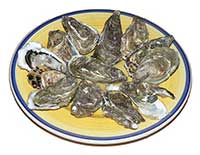 Even though fish and seafood were plentiful they were always very expensive, especially if it were fresh. Fish and seafood were more common in the country side and along the coast due to the proximity to the waters. The main reasons fish and seafood were more expensive in the larger urban areas, was due to the high cost of shipping — fish and seafood went bad quickly and it cost a lot to get it to market fresh enough to eat. Fish were so expensive that some of the rich had fish ponds (piscinae) in their homes.
Even though fish and seafood were plentiful they were always very expensive, especially if it were fresh. Fish and seafood were more common in the country side and along the coast due to the proximity to the waters. The main reasons fish and seafood were more expensive in the larger urban areas, was due to the high cost of shipping — fish and seafood went bad quickly and it cost a lot to get it to market fresh enough to eat. Fish were so expensive that some of the rich had fish ponds (piscinae) in their homes.
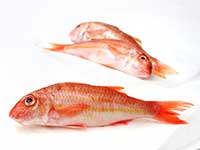 To give you a couple of ideas just how expensive some fish got look at these examples. Cato mentions, while debating sumptuary laws, that a single fish could cost as much as a cow! Seneca also relates that a very large red mullet was presented to Tiberius Caesar and he ordered it to be taken to the market and sold. At the same time he said, “My friends, I am much deceived unless this fish be bought by Apicius or P. Octavius.” Turns out that Apicius did indeed bid against P. Octavius, the Praefect of Egypt, and that Octavius won the bid for 5000 sesterii (very roughly estimated value of 1 Sesterces in 2015 is $1.55 which would place the amount at $7,750USD).
To give you a couple of ideas just how expensive some fish got look at these examples. Cato mentions, while debating sumptuary laws, that a single fish could cost as much as a cow! Seneca also relates that a very large red mullet was presented to Tiberius Caesar and he ordered it to be taken to the market and sold. At the same time he said, “My friends, I am much deceived unless this fish be bought by Apicius or P. Octavius.” Turns out that Apicius did indeed bid against P. Octavius, the Praefect of Egypt, and that Octavius won the bid for 5000 sesterii (very roughly estimated value of 1 Sesterces in 2015 is $1.55 which would place the amount at $7,750USD).
Even though fish and seafood was preferred fresh (cooked grilled, boiled, fried and even stuffed) they were dried, salted, smoked, and pickled as well. The Romans even started fish farming (pisciculture) that included the raising of eels and oysters.
Following is just a small list of fish and seafood the Ancient Romans loved that are easy to get here in the US (especially at Oriental markets):
- Sardines
- Tuna
- Sea Bass
- Snapper
- Mullet (especially Red Mullet)
- Flounder
- Eels (especially Moray Eels)
- Carp
- Tilapia
- Wolf-Fish
- Turbot
- Mackerel
- Cuttlefish
- Anchovies
- Sole
- Bream
And Some non-Fish
- Squid
- Octopus
- Sea Urchin
- Prawns
- Lobster
- Mussels and Oysters.
In all honesty though… just about ANY fish you would find in the Mediterranean Sea would work.
For grins-n-giggles…
The Romans prized the red mullet the most which could fetch thousands of sesterces as mentioned above. However, the sea bass (lupus) that were known to live in the Tiber AND fed off the Cloaca Maxima was a particularly prized delicacy that could fetch an extremely high price. Often, if a fisherman was lucky enough to catch one, it was sold for an extravagant price and ended up on the Emperor’s table.
Wild Game:
The Ancient Roman also enjoyed hare, rabbit, wild boar, deer and roe deer. Poultry and wild game were important sources of meat, but pork, veal, mutton, and goat were also available. While often eaten fresh, meat could also be conserved by salting, drying, smoking, curing, pickling, and preservation in honey.
- A great article on wild game and meat in Roman Britain by Dr. Martyn Allen: Hunting in the Roman world: anthropology, animal bones and ancient literature
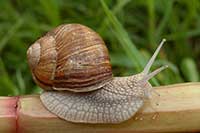 The Ancient Romans also ate frogs (mainly the legs) and snails. The snails were first fattened up with any combination of bran, flour, herbs honey and milk with a mixture of honey and milk being the most popular.
The Ancient Romans also ate frogs (mainly the legs) and snails. The snails were first fattened up with any combination of bran, flour, herbs honey and milk with a mixture of honey and milk being the most popular.
NOTE: Liver was a favorite — any kind of liver: chicken, goose, pork and beef.
Cheese:
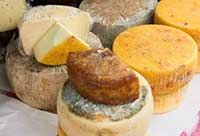 Cheese was basically the only dairy that Ancient Romans ate. It’s interesting that the Romans were not milk (goat or cow) drinkers much at all, yet milk was the number one ingredient feed to snails and dormice to help fatten them up for consumption.
Cheese was basically the only dairy that Ancient Romans ate. It’s interesting that the Romans were not milk (goat or cow) drinkers much at all, yet milk was the number one ingredient feed to snails and dormice to help fatten them up for consumption. 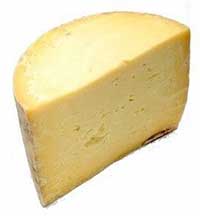 Cheese, like bread, was a staple of the Roman diet, especially amongst the poor, and was standard fair for the Legions. The Ancient Romans utilized just about any kind of milk you can think of into cheese, including hares, rabbits, horse, donkey, deer and camel (camel was the most prized).
Cheese, like bread, was a staple of the Roman diet, especially amongst the poor, and was standard fair for the Legions. The Ancient Romans utilized just about any kind of milk you can think of into cheese, including hares, rabbits, horse, donkey, deer and camel (camel was the most prized).
^^One of the oldest of the French cheeses, Cantal cheese was reportedly enjoyed over 2000 years ago in ancient Rome.
Trivia note: The Romans considered the milk from animals with more than four nipples, such as cats, dogs and pigs as unsuitable. The cow has four nipples and its cheese was considered to be inferior but popular. Sheep and goat milk cheese were the most common with goat’s milk cheese being the most popular.
 The Ancient Romans had fresh cheese (the main type they ate) and cheese that would keep (hard) just like we do today. They were very fond of aged cheese with the ones from Bythynia being very famous. Cheese was imported into Rome from all over the Empire and Pliny states that the cheese from Gaul was by far the best.
The Ancient Romans had fresh cheese (the main type they ate) and cheese that would keep (hard) just like we do today. They were very fond of aged cheese with the ones from Bythynia being very famous. Cheese was imported into Rome from all over the Empire and Pliny states that the cheese from Gaul was by far the best.
The Ancient Romans had soft cheese, hard cheese, curds, smoked cheese (apple wood smoked was the most popular) as well as flavored cheese that has had herbs and spices mixed into them.
Interestingly the Roman Legions are credited with showing the cheese makers outside of Italy how to make hard cheeses.
Here is a cool article on Cheese in the Roman Army.
Cheeses such as Cheddar, Swiss, Parmesan and Gouda, are relatively new, appearing only within the last 500 years. However, there are several out there who claim the Ancient Romans did indeed have Cheddar cheese; however, there is no proof to this. In fact, there is no proof that the Romans even knew of any other cheeses other than white cheeses. Mark Grant, in his book Roman Cookery: Ancient Recipes for Modern Kitchens talks about his experiments in making Roman cheese based on the known ways of making it from Ancient Roman sources. He states that his finished product had a similar taste and character as that of Cheddar. His experiment is about the only indication for Cheddar in the Roman world. Most believe Roman cheeses to be more along the lines of Ricotta and Feta. In reality no one knows what Ancient Roman cheese tasted like or looked like. For an authentic-ish display just about any type of white cheese would work, especially those made with goat’s milk or sheep’s milk.
Premade Condiment Type Ingredients:
Following are the most common premade ingredients the Romans used. I have included the modern equivalent when possible.
Mustard: The first element is ultimately from Latin mustum, ("must", young wine) — the condiment was originally prepared by making the ground seeds into a paste with must. The second element comes also from Latin ardens, (hot, flaming). It was first attested in English in the late 13th century, though it was found as a surname a century earlier.
ANYWAY, Mustard was one of the most common sauces in ancient Rome. Used also alone, it appears as an ingredient for more complex recipes in the cookbook attributed to Marcus Gavius Apicius, in his De Re Coquinaria, but who, sadly, doesn’t give us his own recipe for mustard. The name is derived from mustum ardens, meaning “burning must,” which is not very enlightening, except that it tells us that the first mustards were originally very spicy.
Columella (1st century) and Palladius (4th century), both agronomists, are fundamental sources not only for the agriculture and farming, but also for the many recipes of preserves, sauces, alcoholic beverages, cheese, honey, oil they wrote in their treatises. Differently from Apicius, who writes recipes for rich banquets, Columella and Palladius’ methods are simpler and meant also for farmers and common people.
On this site, we have the mustard recipes of both Palladius and Columella here... Give forth a look:
Garum/liquamen: Hands down go with Red Boat 40N Fish Sauce; its protein-to-salt ratio is as perfect to the real deal as possible. There are many fish sauces out there, but few that come close to the real deal. I have a collection of about a dozen fish sauces, most being from Southeast Asia, with a cost of anywhere from $5 for 500ml to one that was $45 for 100ml. The cheap Asian ones are a lot better than the expensive Italian ones. The $45 dollar one came from a small village not far from Pompeii, yet it sucks!!! I can tell you that the Red Boat 40N sauce blows them all away and will only cost between $6 and $10 for 500ml depending on where you buy it.
Defrutum: This is a grape must syrup that is used really often.
- 2 liters red grape juice
- 5 dried figs
Combine and bring to a gentle simmer and then lower the temp just a tad and let simmer for 2-3 hours. It's finished when the juice has reduced by two-thirds. Don’t toss the figs — they're delicious!
Caroenum: Another grape must syrup, common but not as common as Defrutum.
No one really knows exactly WHAT this is, however the best educated guess is that it is similar to Defrutum but thinner.
*Note: From the Pass the Garum website: Caroenum is barely mentioned in ancient texts, which makes identifying its true nature particularly difficult. We know that it is a grape syrup, made by reducing grape juice/must. According to Grainger and Dalby, it is reduced by 1/3 to ½. They also believe that it was made from white grape juice, and that its purpose was to add 'bulk' to a meal, rather than to flavour it; this task falls to passum and defrutum instead. Caroenum is also used to make 'oenogarum', a 'vinaigrette' made by mixing fish sauce, oil, wine, and spices.
Characteristics
Caroenum is sweet, but not sickeningly so. It is a touch thicker than standard white grape juice.
Finding It
This is something you make at home rather than buy in the shops; as long as you can find a carton of white grape juice, you're set. To make it, pour as much grape juice as you need into a pan and boil until it has reduced by 1/3 to ½. Using a pan with a wide base is recommended, as this will speed up the process of evaporation. Once it has cooled, bottle it up for future use.
Alternatives
If needs be you can just use white grape juice — this will provide sweetness and 'bulk', albeit not as pronounced as with caroenum.
Passum: Passum was a raisin wine (wine from semi-dried grapes) apparently developed in ancient Carthage (now in modern Tunisia) and transmitted from there to Italy, where it was popular in the Roman Empire. The earliest surviving instruction constitutes the only known Carthaginian recipe. It is a fragment from the Punic farming manual by Mago (agricultural writer) in its Latin translation by Decimus Junius Silanus (2nd century BC). It survives because it was summarised by Columella, De Agricultura 12.39.1:
Mago gives the following instructions for excellent passum. Harvest well-ripened very early bunches of grapes; reject any mildewed or damaged grapes. Fix in the ground forked branches or stakes not over four feet apart, linking them with poles. Lay reeds across them and spread the grapes on these in the sun, covering them at night to keep dew off. When they have dried, pick the grapes, put them in a fermenting vat or jar and add the best possible must (grape juice) so that they are just covered. When the grapes have absorbed it all and have swelled in six days, put them in a basket, press them and collect the passum. Next, tread the pressed grapes, adding very fresh must made from other grapes that have been sun-dried for three days. Mix all this and put the mixed mass through the press. Put this passum secundarium into sealed vessels immediately so that it will not become too austerum. After twenty or thirty days, when fermentation has ceased, rack into other vessels, seal the lids with gypsum and cover them with skins.
Malaga Dulce is what Sally Grainer recommends for replicating passum using Malaga Virgen and Malaga Moscatel [sorry, you can't buy wine from Amazon.com here in the US. We need to open an asociates account with Amazon.uk so that we can sell such things ![]() ] Anyway, these wines can be hard to get in the plain ol’ liquor store and also might tend to be expensive. If you can find a Muscat wine it would work. Basically, what you want to find is a VERY sweet dessert wine — preferably a raisin wine.
] Anyway, these wines can be hard to get in the plain ol’ liquor store and also might tend to be expensive. If you can find a Muscat wine it would work. Basically, what you want to find is a VERY sweet dessert wine — preferably a raisin wine.
Date Syrup: Just about any health food store or Middle Eastern food shop will have it.
Oenogarum: This is a common component of Roman cooking but no actual recipe is known, only contemporary Roman descriptions as to what it looks like, tastes like and what it was used for are available.
- 1 part fish sauce
- 1 part medium white wine
- 1 part passum
- 1 part oil
- Generous freshly ground pepper
Combine all of this together at the last minute and use on a salad, on veggies, as a dipping sauce (especially ientaculum). A starch can be added to make a more stable emulsion to pour over finished dishes and boiled eggs.
Hydrogarum: All that is known about this is that it is a cooking sauce that resembles French ‘court bouillon’. Best educated guess is that you water down some fish sauce and add a few herbs and pepper. This is used to poach foods such as eggs and other various meats.
Here are some other things to keep in mind:
All-in-all you can't go wrong just taking the lists above and going to your local market. The fruits, veggies and nuts they knew as "common and everyday" are basically the same as ours. As for meats — go with chicken first, then pork (ham and slab bacon or chops) and then a common fish. Steer clear of beef. Top it off with rustic bread, white cheese and watered wine.
The diet and ingredients changed with the location, i.e. in Greece, Britain, Africa and so on.
Apicius and some thoughts...
Many, many recipes that you might find on Roman reenacting sites — including Roman military ones, typically have recipes from Apicius' "De Re Coquinaria". This cookbook is the only extent cookbook to survive from Ancient Rome; it is also, however, a cookbook intended for the wealthy of Rome — NOT for the common person and definitely not for the military! It does though, give a good idea of what the common ingredients were and what flavor combinations the Romans liked. To give you an illustration of what I'm getting at, just take a look at the work of Georges Auguste Escoffier. He is one of the fathers of French 'haute cuisine' and published the cookbook "Le Guide Culinaire" which is still considered one of the bibles used in the best culinary schools around the world. His recipes would show up in Michelin 3 star restaurants such as Alléno Paris au Pavillon Ledoyen in Paris, Alain Ducasse at the Dorchester in London and The French Laundry in CA. On their menus you will find dishes such as Tarte aux Pignons and Oeufs Aurore. These are NOT ordinary restaurants and definitely NOT ordinary food you'll find at home. Yet this is the reality of Apicius' recipes — they are NOT normal. Apicius is good at providing basic ideas on how to combine the herbs, spices and other ingredients, but most people fail to take this knowledge and create what would have been the "norm" of Roman cooking. [Buy Mark Grant's book Roman Cookery: Ancient Recipes for Modern Kitchens for that]
The recipes in "De Re Coquinaria" were made to impress. The typical Roman ate simple fair — bread, fresh fruit and veggies, cheese, porridge and stews. The meats were either used as an ingredient in the stews for flavor or were simply fired, grilled, boiled or, at times baked.











